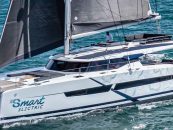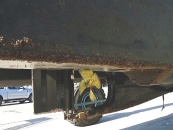Local boating legend Ross Muir has tirelessly handcrafted two timber dinghies, paying homage to his family’s classic yachts from the 1900s. Many Brisbane boaties will know Ross from his work managing Muir Marine in Manly for 28 years.
The Muir contribution to boating is huge, stretching well beyond Ross’ time in Manly, to his father Jock’s boat building business in Hobart’s Battery Point in the mid-1900s. “Jock was always passionate about yachts, building his first boat, Westwind, just before World War II,” Ross enthused. “Later he did some boat building for the Navy in Sydney before moving back to Tassie [Tasmania] and establishing the Muir boat yard. He designed his first Tassie boat in 1946, and called it Westward. Unfortunately, as he was beginning the build, the buyer cancelled the order. One of Jock’s friends helped him finish the boat and they sailed it together in the 1947 and 1948 Sydney to Hobart yacht race, winning it both years. They still hold the record for being the only Tassie boat to win two races.”
It was at the family boat yard that Ross began his own apprenticeship in the early 1960s. Ross developed his boat-making skills, while his father was building Balandra for the Admiral’s Cup team in 1967. Not long after, Jock built Trevassa, which he finished in 1971. The former owner later sold Trevassa to the Muir family in 2012. Ross, along with his brothers John and Greg, painstakingly restored the yacht. In particular, Ross handcrafted a beautiful custom steering wheel and table. In the years that followed, they raced the yacht in several events, including the Bruny Island Race and the Channel Regattas. It is clear this 48-foot yacht holds immense sentimental value to Ross and his family, so it was fitting that Ross named his recent Huon Pine timber dinghy Trevassa Too.
After finishing his apprenticeship with his father in the 1960s, Ross began running his own successful marine boat-building, rigging, and chandlery in Hobart. In 1987, Ross made the decision to move his family up to Manly, where he still lives today. “We were keen for a change and we had always liked Queensland when we had come up for regattas in the past,” Ross explains. “The weather is so much warmer, and it is much easier to get around Australia and to travel overseas from here.”
Along with timber boating, it is clear Ross is equally proud of Manly. “This harbour has pretty much everything boaties could ask for. The marinas are full. We have the hotels and supermarkets in place too. And, of course, the Royal Queensland Yacht Squadron is the biggest and best yacht club in Australia. We just had the Etchells world championships here, with 96 boats, and 350 yachtsman and their families. Moreton Bay is so well protected too, with the Stradbroke islands and the Tangalooma wrecks offering so many great sheltered spots. Peel Island is really popular too.”
Ross further believes that Manly is a real mecca for boating. “Manly sure has changed a lot over the years. I remember when I first visited in 1969, there were only a few boats moored here in the whole harbour. Now, 50 years on, the harbour is absolutely filled with boats. It is the biggest boat harbour on the east coast, and the second biggest in the country. Only Fremantle is bigger because it is more of a commercial port, and it was expanded for the 1987 America’s Cup.”
The Muir Marine business opened in 1988, after Ross took over a local chandlery shop. True to his Tasmanian roots, Ross has kept the business focused on boat rigging and chandlery, and has kept the shop open seven days a week, with the help of his son, Jason.
Jason is also an avid sailor. “At the age of 14 he won the Sabots National, and has won many Australian titles since then in the 420s class and Etchells,” shares Ross. “He went on to win the 2009 Etchell Worlds. We both attended a sail-making course together, and since then Jason has been working in the shop with me. Two years ago, I handed the reigns of the business over to Jason. Now the shop just celebrated its 30th anniversary, and I could not be happier that he took the helm and that his kids are our fifth generation of sailors.”
When Jason took over the shop, it gave Ross the perfect opportunity to reignite his passion for timber boat-building. To avoid the mess and headaches associated with a home workshop, Ross decided to set himself up with a couple of benches and tools, all snuggly packed into a shipping container sitting out the front of Muir Marine. To successfully build the two classic dinghies Ross split his time between his Manly workshop, where the accessories are made, and Hobart, where he does all the hard yakka on the boat hulls.
Both of the timber dinghies are tributes to the work of Ross’ family and friends. “The first dinghy I built was the 10-foot Trevassa Too. I crafted it out of Tasmanian Blackwood and Huon Pine. There is a bit of history behind the design as well. It is based on a Foster 10 design, created by Bill Foster. Bill is 86 now, but he was just 14 when he worked as Dad’s apprentice on Westward. I did modify the Foster 10 design a little though, making it a traditional full skiff rig, just like the old boats,” Ross enthused.
The second dinghy, Kittywake IV, was built as a tribute to Ross’ friend Bruce Darcy, who assisted Ross to win the Stonehaven Cup in the 12-foot cadet class dinghy, Venom. “This dinghy is based on the same 1921 cadet clinker dinghy design. The cadet was introduced as an alternative for younger sailors who were not old enough for the traditional 21-foot restricted class. The cadet dinghies later moved to fibreglass, so this is the first timber cadet to be built in 40 years,” Ross recalled.
As one can imagine, the building process for these dinghies is extremely labour intensive. Ross put about six months of labour into each one. Two-thirds of that time is spent constructing and varnishing the hull and trolley in Hobart. In his container workshop Ross handcrafts all the remaining accessories, including the spars, oars, bowsprits, paddles, bailers and rudders. “Timber boats have always been my passion. Building these dinghies lets me revive the family traditions I learnt as an apprentice back in the 1960s.”
The way Ross talks about his work clearly indicates how much love he has for Australian timber. “Huon Pine is beautiful to sand, and to work with. It is some of the best timber in the world. Growing oil in it and is very much like teak. Trevassa Too is all planked and ribbed in Huon Pine, including the trims on the accessories. Kittywake IV has a combination of Huon Pine and Australian Red Cedar, which has been used since the early days because it is light and strong.”
Unfortunately, the timber boat-building industry has been in a steady decline since the 1960s. Ross believes the decline was caused by the introduction of fibreglass, rather than anti-logging movements. “The timber boat-building scene is tiny now. There are just a few businesses today building the big timber boats. When fibreglass came in during the 1960s, it made it very hard for timber boat businesses to remain competitive. Asking customers to wait two to three years for a wooden boat is a big ask, compared to, say, picking up a new Riviera or Maritimo instantly.”
The lack of demand for Tasmania’s top-notch timber is disappointing for Ross, who points out there is currently ample supply. “The forestry department has stockpiles of Huon Pine these days. Now they have some amazing equipment enabling them to access the trees in flooded areas. The machinery can go down 30 metres underwater, and cut the trees off at the base. It is nothing like it was thirty to forty years ago when Huon Pine was in short supply because of all the flooding of the valleys required for the hydro projects.”
Timber boats certainly are not for everyone because the costs and maintenance involved can be extreme. However, for people like Ross Muir, who love timber and the history of boating, nothing beats classic wood.
By Narayan Pattison



























